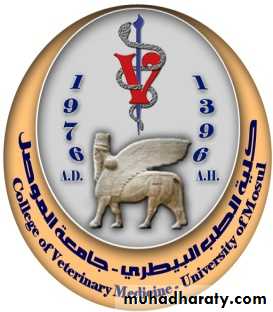Department of Surgery & Obstetrics
College of Veterinary MedicineUniversity of Mosul
Sterilization
Department of Surgery & Obstetrics
College of Veterinary MedicineUniversity of Mosul
Sterilization of surgical Equipment and materials
Sterilization
It is defined as complete destruction of living organisms. Sterilization is the complete elimination of microbial viability including both the vegetative forms of bacteria and spores.
Methods of sterilization
Physical methodschemicals methods
Department of Surgery & Obstetrics
College of Veterinary MedicineUniversity of Mosul
Physical methods
Thermal energyFiltration
Radiation energy
Department of Surgery & Obstetrics
College of Veterinary MedicineUniversity of Mosul
Sterilization by thermal energy
Mechanism by which heat destroy microorganisms is not perfectly understood, Denaturation or destruction of cellular proteinDry heat
Moist heatBacteria are destroyed by either wet or dry heat, although when moisture is present death occurs at lower temp. and shorter period of time, bacterial spores show greater resistance to dry heat than moist heat.
Hot air oven:
160° C, 3 hr.
Sterilizer
Auto claveDepartment of Surgery & Obstetrics
College of Veterinary MedicineUniversity of Mosul
Moist heat:
Autoclave means self closing121 °C , 15 minute 1.5 Bar
It is killed both spore and vegetative form of bacteria
Suitable for all instruments, cotton, gauze
Dry heat:
can sterilization surgical instrument, disadvantage, can not sterilization , clothes, cotton, gauze , also destroy sharpness of instrument
Department of Surgery & Obstetrics
College of Veterinary Medicine
University of Mosul
Steam sterilization procedure:
1- Cleaning of surgical supplies prior to sterilization:Gross contamination must be removed from surgical instrument, instrument usually should be cleaned after used either manually, or with ultrasonic cleaning equipment, Instrument should be rinsed with cold water to remove blood finally should washed with warm water containing detergent. The instrument are loaded loosely in wire mesh trays and dried
2- Preparation of surgical packs and loading of the autoclave.
Instruments and supplies should be packed according to their intended use, the system of packing should be standardized, each type of pack should always contain the same material. Materials should be positioned in pack to allow complete steam penetration3-Autoclave operation (121 C, 15 minute 1.5 bar). A number of indicator system are available to monitor the effectiveness, indicator placed in the center of each pack. All indicators undergo either chemical or biological changes in response
Department of Surgery & Obstetrics
College of Veterinary MedicineUniversity of Mosul
Chemical indicators most commonly are paper strips impregnated with chemical that undergoes a color change when certain temp. is reached
Biological indicators are superior to chemical indicators, all system employ a heat resistant organism, most commonly used spore of Bacillus stearothermophilus
4- Sterile pack storage: sterile pack should stored in closed cabinets, pack should be dated, safe storage times for packs wrapped in commonly used , 1-7 week.
Department of Surgery & Obstetrics
College of Veterinary MedicineUniversity of Mosul
Sterilization by filtrations
Filtration refers to the separation of particulate material from liquid and gases. The mechanism which microorgansims or other particles are removed. Pharmaceuticals are commonly sterilized by filtrationSterilization by Radiation
Radiation kills organisms by producing ionization in or near the organism, Gamma rays, X-ray, and ultraviolet rays , certain materials sensitive to heat or chemicals are sterilization by radiation, tissue grafts, gamma radiations, surgical gloves
Department of Surgery & Obstetrics
College of Veterinary MedicineUniversity of Mosul
Chemicals sterilization
It refers to the use of gaseous or liquid chemicalsIt developed to sterilize materials that are damaged by wet or dry heat
Gaseous agents
Ehylene oxideFormaldehyde
Betapropiolactone.
Liquid agents
Department of Surgery & Obstetrics
College of Veterinary MedicineUniversity of Mosul
Ethylene oxide
It is most popular gaseous agents > It is flammable and explosive except when mixed with carbon dioxide. It is capable to destroying all known microorganism including bacteria, spores, fungi, and larger virusFormaldehyde
Pure formaldehyde is a white solid that gives off gaseous formaldehyde at room temperature. Formaldehyde gas has been used to sterilize medical and surgical equipment, vegetative form killed within 1-2 hours. Up to 12 hours is required to kill bacterial spores
Betapropiolactone
Betapropiolactone has been used to sterilize hospital rooms and animal housing buildings. It acts more rapidly than does either ethylene and formaldehyde main disadvantage , damage plastic surface highly toxic and carcogenic
Department of Surgery & Obstetrics
College of Veterinary Medicine
University of Mosul
Cold sterilization:
It refers to the practice of soaking instruments in disinfectant solutionsDisinfectant
It is an agent that destroy all organism on non living tissue
Antiseptic:
It is an agent that inhibition growth of pathogenic organisms on living tissue
Department of Surgery & Obstetrics
College of Veterinary MedicineUniversity of Mosul
Alcohols:
Ethyl alchol and isopropery alcohol kill bacteria by the coagulation of protein, Ethanol is generally used as 70% solution, and isopropyl alcohol is effective in concentration up to 99%
Aldehydes:
Formaldehyde is available as fromaline 1 37% solution, it capable to kill all bacteria, viruses, and spores, it is toxic and irritant to skin. Glutaraldehyde in dilute concentration is less toxic than formaldehyde and has similar activity
Chlorhexidine:
This is antiseptic agent available in detergent, tincture, and aqueous formaulation, used as an agent for skin preeration
Department of Surgery & Obstetrics
College of Veterinary MedicineUniversity of Mosul
Iodines:
Inorganic iodine are good bactericidal agents but stain fabrics and tissue. They have good viricidal but poor sporicidal activity. Concentration more than 3.5% are toxic to tissuePhenol or carbolic acid is oldest known germicidal agent, phenolic derivatives have replaced phenol generally and may be divided into two groups. Cresol used as disinfectants on environmental surface, and bisphenol are used as antiseptics
Quaternary ammonium compounds:
Such as benzalkonium cholride are synthetic detergents
Department of Surgery & Obstetrics
College of Veterinary MedicineUniversity of Mosul
Principles of Surgical Asepsis
Department of Surgery & ObstetricsCollege of Veterinary Medicine
University of Mosul
Wound infection have been a major problem since surgery began, Surgeon developed many methods to prevent wound infection. Wound infection still occur today. The increased use of antimicrobial agent tend to decrease wound infection
Prevention of nosocomial (hospital acquired) infections requires strict attention to all details of aseptic technique
Department of Surgery & Obstetrics
College of Veterinary MedicineUniversity of Mosul
Asepsis:
Absence of pathogenic microbes in living tissue
Sterilization:
Is the process of killing all microorganism with the use of either Physical or chemical agents
Antiseptic:
It is a chemical agent that either kills pathogenic microorganism or inhibits their growth it is reversed for agents applied to the body.
Disinfectant:
It is chemical substance that kills microorganisms on non living tissue, such as instrument and equipment that can not exposed to heat
Department of Surgery & Obstetrics
College of Veterinary MedicineUniversity of Mosul
Antimicrobial drugs
Drugs used to alter activity of microbial agent in the patientBacteriostatic: It is antimicrobial agents inhibit growth of bacteria
Bactericidal : Agent that killed bacteria
Department of Surgery & Obstetrics
College of Veterinary MedicineUniversity of Mosul
Types of Surgical infections:
There are four major settings:1- Primary surgical disease
2-Complication of an operation
3-Complication of diagnostic or support procedures
4-Infectious unrelated to the primary surgical disease
Department of Surgery & Obstetrics
College of Veterinary MedicineUniversity of Mosul
Prevention of surgical infection
1-Proper selection and preparation of the patient2-Surgical personnel preparation
3-Adequte sterilization of surgical equipment and materials
4- Proper maintenance of the surgical rooms
5- Attention to operative technique
6- Correct patient aftercare
7- Proper use of prophylactic antimicrobial agents


